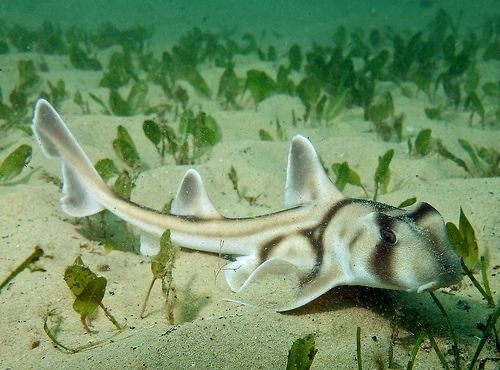The Incredibly Stunning Port Jackson Shark, Which Lives On Coastal Reefs In Australia



The incredibly stunning Port Jackson Shark, which lives on coastal reefs in Australia

Though it can be solitary it prefers to stay in small groups and explore the sea floor with its friends



What I love most about this shark is how surreal it looks due to the patterns of its skin

It is friendly and curious of people

An oviparous shark, it lays spiral eggs to keep the current from dragging babies into the open ocean

Probably the coolest shark jaw I’ve ever seen, most of its teeth are round and flat in order to crush clams and mollusks
More Posts from Csmsdust and Others

Walnut shells cut in half.
“You look at trees and called them ‘trees,’ and probably you do not think twice about the word. You call a star a ‘star,’ and think nothing more of it. But you must remember that these words, ‘tree,’ ‘star,’ were (in their original forms) names given to these objects by people with very different views from yours. To you, a tree is simply a vegetable organism, and a star simply a ball of inanimate matter moving along a mathematical course. But the first men to talk of ‘trees’ and ‘stars’ saw things very differently. To them, the world was alive with mythological beings. They saw the stars as living silver, bursting into flame in answer to the eternal music. They saw the sky as a jeweled tent, and the earth as the womb whence all living things have come. To them, the whole of creation was ‘myth-woven and elf patterned’.”
— J.R.R. Tolkien, from ‘Mythopoeia’


Really interesting part of the book I just started reading
The Myth of Dreamless Sleep
Consciousness never "switches off" because it isn't generated by the brain. Its sensory inputs can be switched off - during sleep or general anesthesia, for instance - but your consciousness is still there. For example, a small but consistent number of patients report out-of-body experiences (OOBEs) or near-death experiences (NDEs) while under general anesthesia. As someone with REM Sleep Behavior Disorder (RBD) I can attest to this, since I act out dreams that occur during the non-REM phases of sleep.


Mouse brain labeled using the brainbow technique. Brainbow is a technique used to distinguish individual neurons using different-colored derivatives of GFP (green fluorescent protein). By Dr. Tamily Weissman-Unni.



Mouse embryo (day 12.5) stained for motor (red) and sensory (magenta) nerves and nerve endings (cyan)
By Dr. Gist F. Croft, Lauren Pietila, Dr. Ali H. Brivanlou (The Rockefeller University - Laboratory of Stem Cell Biology and Molecular Embryology)
Technique: Light Sheet Microscopy and Tissue Clearing (iDISCO)
Magnification 1.8x (objective lens magnification)


Starting uni again + honorable mention, my support animals
-
 tealcrush reblogged this · 1 month ago
tealcrush reblogged this · 1 month ago -
 tealcrush liked this · 1 month ago
tealcrush liked this · 1 month ago -
 wishicouldcomeupwithanameforthis liked this · 3 months ago
wishicouldcomeupwithanameforthis liked this · 3 months ago -
 shenaniiigans reblogged this · 6 months ago
shenaniiigans reblogged this · 6 months ago -
 shenaniiigans liked this · 6 months ago
shenaniiigans liked this · 6 months ago -
 wildernestt liked this · 7 months ago
wildernestt liked this · 7 months ago -
 reefsharkivist liked this · 8 months ago
reefsharkivist liked this · 8 months ago -
 sachart liked this · 8 months ago
sachart liked this · 8 months ago -
 hopefulposting liked this · 10 months ago
hopefulposting liked this · 10 months ago -
 a-drunk-50s-queer-housewife reblogged this · 10 months ago
a-drunk-50s-queer-housewife reblogged this · 10 months ago -
 a-drunk-50s-queer-housewife liked this · 10 months ago
a-drunk-50s-queer-housewife liked this · 10 months ago -
 frankencanon liked this · 10 months ago
frankencanon liked this · 10 months ago -
 a-sentient-cup reblogged this · 10 months ago
a-sentient-cup reblogged this · 10 months ago -
 barsom-fearce reblogged this · 10 months ago
barsom-fearce reblogged this · 10 months ago -
 barsom-fearce liked this · 10 months ago
barsom-fearce liked this · 10 months ago -
 moonbeamlevels reblogged this · 10 months ago
moonbeamlevels reblogged this · 10 months ago -
 moonbeamlevels liked this · 10 months ago
moonbeamlevels liked this · 10 months ago -
 spellinwaiting reblogged this · 10 months ago
spellinwaiting reblogged this · 10 months ago -
 marineparty reblogged this · 10 months ago
marineparty reblogged this · 10 months ago -
 trkncore reblogged this · 11 months ago
trkncore reblogged this · 11 months ago -
 mogamuncher reblogged this · 11 months ago
mogamuncher reblogged this · 11 months ago -
 cilantroodon reblogged this · 1 year ago
cilantroodon reblogged this · 1 year ago -
 childofdemon liked this · 1 year ago
childofdemon liked this · 1 year ago -
 chaoticbi99 reblogged this · 1 year ago
chaoticbi99 reblogged this · 1 year ago -
 nocturnal-halcyon liked this · 1 year ago
nocturnal-halcyon liked this · 1 year ago -
 chaoticbi99 liked this · 1 year ago
chaoticbi99 liked this · 1 year ago -
 sugaroto reblogged this · 1 year ago
sugaroto reblogged this · 1 year ago -
 sugaroto liked this · 1 year ago
sugaroto liked this · 1 year ago -
 amaliatheartist liked this · 1 year ago
amaliatheartist liked this · 1 year ago -
 captainkaltar liked this · 1 year ago
captainkaltar liked this · 1 year ago -
 ashbakche reblogged this · 1 year ago
ashbakche reblogged this · 1 year ago -
 ashbakche liked this · 1 year ago
ashbakche liked this · 1 year ago -
 mayathescientist liked this · 1 year ago
mayathescientist liked this · 1 year ago -
 noheadthoughtsemptyig liked this · 1 year ago
noheadthoughtsemptyig liked this · 1 year ago -
 aluminia reblogged this · 1 year ago
aluminia reblogged this · 1 year ago -
 aluminia liked this · 1 year ago
aluminia liked this · 1 year ago -
 somerandomdog511 liked this · 1 year ago
somerandomdog511 liked this · 1 year ago -
 iz-hands reblogged this · 1 year ago
iz-hands reblogged this · 1 year ago -
 cythereafemme liked this · 1 year ago
cythereafemme liked this · 1 year ago -
 beanztrash liked this · 1 year ago
beanztrash liked this · 1 year ago -
 big-flrda-kys reblogged this · 1 year ago
big-flrda-kys reblogged this · 1 year ago -
 steinozean reblogged this · 1 year ago
steinozean reblogged this · 1 year ago -
 thegayest-airconditioner liked this · 1 year ago
thegayest-airconditioner liked this · 1 year ago -
 dahliasgloom reblogged this · 1 year ago
dahliasgloom reblogged this · 1 year ago
